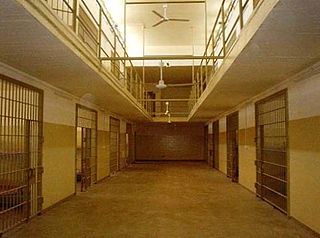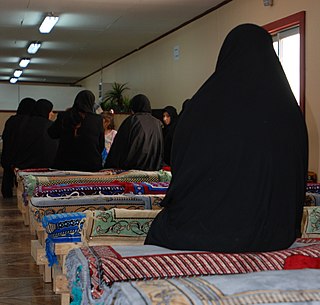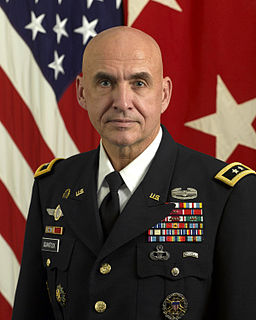
The United States Disciplinary Barracks (USDB) colloquially known as Leavenworth, is a military correctional facility located on Fort Leavenworth, a United States Army post in Kansas.

Abu Ghraib prison was a prison complex in Abu Ghraib, Iraq, located 32 kilometers (20 mi) west of Baghdad. Abu Ghraib prison was opened in the 1950s and served as a maximum-security prison with torture, weekly executions, and squalid living conditions. From the 1970s, the prison was used by Saddam Hussein and later the United States to hold political prisoners. It developed a reputation for torture and extrajudicial killing, and was closed in 2014.

Abu Ghraib is a city in the Baghdad Governorate of Iraq, located just west of Baghdad's city center, or northwest of Baghdad International Airport. It has a population of 189,000 (2003). The old road to Jordan passes through Abu Ghraib. The government of Iraq created the city and Abu Ghraib District in 1944.

Camp Bucca was a forward operating base that housed a theater internment facility maintained by the United States military in the vicinity of Umm Qasr, Iraq. After being taken over by the U.S. military in April 2003, it was renamed after Ronald Bucca, a NYC fire marshal who died in the 11 September 2001 attacks. The site where Camp Bucca was built had earlier housed the tallest structure in Iraq, a 492-meter-high TV mast.

During the early stages of the Iraq War, members of the United States Army and the CIA committed a series of human rights violations and war crimes against detainees in the Abu Ghraib prison in Iraq, including physical and sexual abuse, torture, rape, sodomy, and the killing of Manadel al-Jamadi. The abuses came to public attention with the publication of photographs of the abuse by CBS News in April 2004. The incidents caused shock and outrage, receiving widespread condemnation within the United States and internationally.
About six months after the United States invasion of Iraq of 2003, rumors of Iraq prison abuse scandals started to emerge.
Camp Cropper was a holding facility for security detainees operated by the United States Army near Baghdad International Airport in Iraq. The facility was initially operated as a high-value detention site (HVD), but has since been expanded increasing its capacity from 163 to 2,000 detainees. Former Iraqi President Saddam Hussein was held there prior to his execution. Mr. Hussein was held at a nearby location outside the Camp Cropper complex. He was isolated from the former Baath Party and subsequent HVT’s held at the main Cropper facility.
Ghost detainee is a term used in the executive branch of the United States government to designate a person held in a detention center, whose identity has been hidden by keeping them unregistered and therefore anonymous. Such uses arose as the Bush administration initiated the War on Terror following the 9/11 attacks of 2001 in the United States. As documented in the 2004 Taguba Report, it was used in the same manner by United States officials and contractors of the Joint Interrogation and Debriefing Center at the Abu Ghraib prison in Iraq in 2003–2004.

Arab Liberation Front is a minor Palestinian political party, previously controlled by the Iraqi-led Ba'ath Party, formed in 1969 by Ahmed Hassan al-Bakr and then headed by Saddam Hussein. ALF is a member of the Palestine Liberation Organization (PLO).

The Battle of Abu Ghraib was a battle between Iraqi insurgents and United States forces at Abu Ghraib prison on April 2, 2005.

The Fay Report, officially titled Investigation of Intelligence Activities at Abu Ghraib, was a military investigation into the torture and abuse of prisoners at the Abu Ghraib prison in Iraq. It was sparked by leaked images of Iraqi prisoners, hooded and naked, being mistreated obtained by the United States and global media in April 2004. The Fay Report was one of five such investigations ordered by the military and was the third to be submitted, as it was completed and released on August 25, 2004. Prior to the report's release, seven reservist military police had already been charged for their roles in the abuse at the prison, and so the report examined the role of military intelligence, specifically the 205th Military Intelligence Brigade that was responsible for the interrogation of prisoners at Abu Ghraib. General Paul J. Kern was the appointing authority for the report and oversaw the investigation. The chief investigators were Major General George Fay, whom the report is named after, and Lieutenant General Anthony R. Jones.
Task Force 6–26 is a United States Joint military/Government Agency, originally set-up to find "High Value Targets" (HVT's) in Iraq in the aftermath of Operation Iraqi Freedom. This Special Operations unit is very similar to Task Force 121 which was created to capture Saddam Hussein and high-ranking Al-Qaeda members. The name keeps changing for Operational Security reasons. The main objective of Task Force 6–26 was the capture or liquidation of terror leader Abu Musab al-Zarqawi, who led Al-Qaeda in Iraq. The unit is made up of U.S. Special Operations Forces members including Delta Force, DEVGRU, 24th Special Tactics Squadron and the 75th Ranger Regiment along with the CIA's Special Activities Center. Other military and DIA personnel are believed to have been involved as 'limited' members of the unit, along with FBI agents.
The Hamdania incident refers to the alleged kidnapping and subsequent murder of an Iraqi man by United States Marines on April 26, 2006 in Al Hamdania, a small village west of Baghdad near Abu Ghraib. An investigation by the Naval Criminal Investigative Service resulted in charges of murder, kidnapping, housebreaking, larceny, Obstruction of Justice and conspiracy associated with the alleged coverup of the incident. They were forced to drop many charges on the defendants. The defendants are seven Marines and a Navy Corpsman. As of February 2007, five of the defendants have negotiated pleas to lesser charges of kidnapping and conspiracy, or less, and have agreed to testify in these trials. Additional Marines from the same battalion faced lesser charges of assault related to the use of physical force during interrogations of suspected insurgents. Those charges were dropped.

Abu Musab al-Zarqawi, born Ahmad Fadeel al-Nazal al-Khalayleh, was a Jordanian jihadist who ran a terrorist training camp in Afghanistan. He became known after going to Iraq and being responsible for a series of bombings, beheadings, and attacks during the Iraq War, reportedly "turning an insurgency against US troops" in Iraq "into a Shia–Sunni civil war". He was sometimes known by his supporters as the "Sheikh of the slaughterers".

On 12 April 2007, the canteen of the Council of Representatives of Iraq building was attacked by a suicide bomber, killing one to eight people and wounding 23 others. The attack, in the heavily fortified Green Zone of Baghdad, occurred ten minutes after the Council of Representatives had adjourned for lunch. It was on the first floor of the Baghdad Convention Center, which houses the parliament. Two further unexploded suicide vests were found near the canteen. The building had earlier been searched by dogs – very rare considering dogs are considered ritually unclean by Iraqis – suggesting the authorities suspected an attack was imminent. Following the attack the government closed down mobile phone networks and Apache helicopters flew overhead.
Hassan Ghul, born Mustafa Hajji Muhammad Khan, was a Saudi-born Pakistani member of al-Qaeda who revealed the kunya of Osama Bin Laden's messenger, which eventually led to Operation Neptune Spear and the death of Osama Bin Laden. Ghul was an ethnic Pashtun whose family was from Waziristan.

The Global War on Terrorism (GWOT), popularly known as the "war on terror", is the term that refers to an ongoing international military campaign launched by the United States government following the September 11 attacks. The targets of the campaign are primarily Islamist groups located throughout the world, with the most prominent groups being al-Qaeda, as well as the Islamic State and their various franchise groups.

Lieutenant General David E. Quantock is a retired senior officer of the United States Army who served as Inspector General of the United States Army from 2014 to 2018.
On 22 December 2011, a series of coordinated attacks occurred in Baghdad, Iraq, killing 69 people. This was the first major attack following U.S. withdrawal from Iraq.

Adnan Latif Hamid al-Suwaydawi al-Dulaymi, also known by his noms de guerre Abu Muhannad al-Suwaydawi, Abu Abdul Salem, and Haji Dawūd was a top commander in the Islamic State of Iraq and the Levant (ISIL) and the former head of its Military Council.












